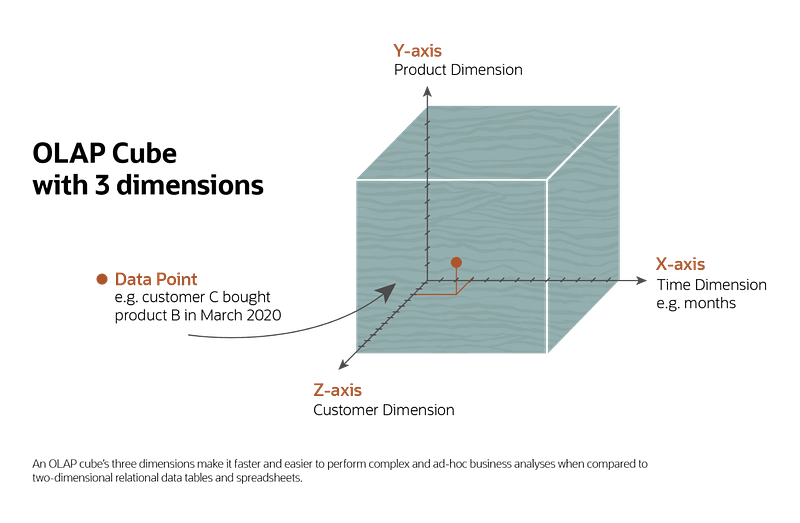
Introduction to Multidimensional Online Analytical Processing (MOLAP)
In the modern era of data-driven decision-making, businesses are constantly searching for ways to analyze and process their vast amounts of data. One such method is Multidimensional Online Analytical Processing (MOLAP), a powerful technique for data processing and analysis. This comprehensive guide will walk you through the key concepts, benefits, and tools associated with MOLAP, providing a thorough understanding of how it can be leveraged in various business scenarios.
Understanding the Basics of MOLAP
Multidimensional Online Analytical Processing (MOLAP) is an advanced data processing technology that allows users to analyze multidimensional data from various perspectives. MOLAP is a type of Online Analytical Processing (OLAP), which is a broader category of computer processing that deals with the analysis of data stored in databases.
In the MOLAP model, data is stored in a multidimensional array or cube, which can be visualized as a three-dimensional structure. Each dimension represents a different aspect of the data, such as time, geography, or product. By analyzing the data in this format, users can gain valuable insights and make data-driven decisions more efficiently.
Key Concepts of MOLAP
There are several key concepts to understand when working with MOLAP, including:
Dimensions: Dimensions are the basic building blocks of a MOLAP cube. They represent the categories or attributes used to organize and analyze the data. Common dimensions include time, geography, and product.
Measures: Measures are the numeric values that represent the data being analyzed. They are usually stored within the MOLAP cube’s cells and are associated with a particular combination of dimensions. Examples of measures include sales, revenue, and profit.
Hierarchies: Hierarchies are the logical relationships between different levels of a dimension. They help users navigate and drill down into the data. For example, a time hierarchy may include levels such as year, quarter, month, and day.
Aggregations: Aggregations are pre-calculated summary values that speed up the process of retrieving data from the MOLAP cube. They can include functions such as sums, averages, and counts.
MDX (Multidimensional Expressions): MDX is a query language specifically designed for querying and manipulating multidimensional data stored in OLAP databases. It allows users to define complex calculations and retrieve data from MOLAP cubes.
Benefits of MOLAP
There are several advantages to using MOLAP for data analysis, including:
Improved Performance: MOLAP cubes store pre-aggregated data, which means that queries can be executed faster compared to traditional relational databases. This is especially beneficial when dealing with large volumes of data.
Flexible Data Analysis: MOLAP allows users to analyze data from multiple dimensions and perspectives, making it easier to identify trends, patterns, and anomalies.
Intuitive Data Visualization: The multidimensional nature of MOLAP cubes makes it easy to visualize data and understand the relationships between different dimensions.
Scalability: MOLAP systems are highly scalable, allowing them to handle large volumes of data and support growing business needs.
Enhanced Decision-making: MOLAP tools enable businesses to make data-driven decisions by providing timely and accurate insights into their operations and performance.
Top MOLAP Tools for Effective Data Analysis
A wide range of MOLAP tools is available to cater to various data analysis needs. Here, we present some of the most prominent MOLAP tools that offer unique features and capabilities:
Microsoft SQL Server Analysis Services (SSAS): SSAS is an integrated part of the Microsoft SQL Server suite, providing a powerful and scalable platform for developing, managing, and deploying MOLAP cubes. It supports both multidimensional and tabular data models, as well as a range of advanced analytics capabilities.
Oracle Essbase: Oracle Essbase is an enterprise-grade MOLAP solution that offers advanced analytics and multidimensional data modeling capabilities. It is designed to provide rapid, accurate, and flexible data analysis, making it a popular choice among large organizations with complex data requirements.
IBM Cognos TM1: IBM Cognos TM1 is a high-performance MOLAP tool that allows users to create and manage multidimensional data models, perform real-time data analysis, and generate insightful reports. It is known for its in-memory processing capabilities, making it well-suited for handling large datasets and complex calculations.
SAP BusinessObjects: SAP BusinessObjects is a comprehensive business intelligence (BI) platform that offers a wide range of analytics capabilities, including MOLAP. It provides powerful data modeling and visualization tools, enabling users to create and manage MOLAP cubes and gain actionable insights from their data.
MicroStrategy: MicroStrategy is a robust BI and analytics platform that supports MOLAP data modeling and analysis. It offers a comprehensive suite of tools for creating, managing, and analyzing MOLAP cubes, as well as advanced data visualization and reporting features.
Pentaho: Pentaho is an open-source BI and analytics platform that includes MOLAP capabilities through its integration with the Mondrian OLAP server. It offers a flexible and extensible solution for multidimensional data analysis and reporting, making it a popular choice for businesses looking for cost-effective MOLAP options.
Summary
By selecting the right MOLAP tool for your organization, you can take advantage of the many benefits that multidimensional data analysis has to offer. These tools empower businesses to make data-driven decisions by providing timely, accurate, and actionable insights into their operations and performance.